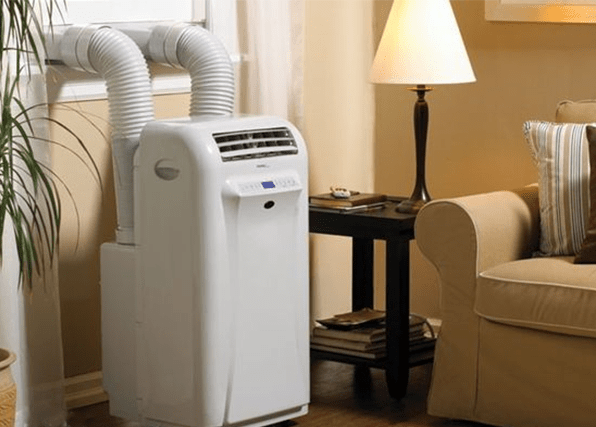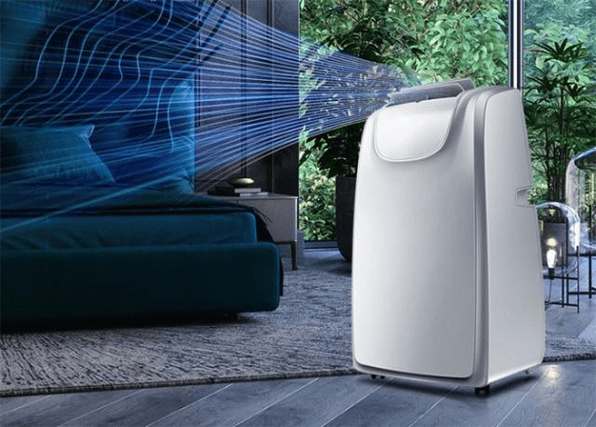
Figure 1: Portable heat pump.
Portable heat pumps are becoming an increasingly popular option for homeowners who want to efficiently heat and cool their homes without the need for ductwork. These devices are designed to move heat from one place to another, making them highly efficient and environmentally friendly.
These devices can be moved from room to room, making them ideal for small apartments or homes where space is limited. But are portable heat pumps efficient for home heating and cooling? In this article, we'll explore the basics of portable heat pumps, their pros and cons, and look at how they compare to other heating and cooling options.
What is a Portable Heat Pump and How Does It Work?
A portable heat pump is a small, self-contained unit that can be moved from one room to another to provide heating and cooling. These devices typically have wheels or casters for easy mobility and can be plugged into a standard electrical outlet.
Portable heat pumps work by transferring heat from one place to another using refrigerant. They are designed to be mobile and can be easily moved from room to room or building to building.
Here's a more detailed explanation of how they work:
1.The heat pump extracts heat from the air (the most common type of portable heat pump is an air-source heat pump). This is done using a refrigerant, which absorbs the heat as it evaporates.
2.The refrigerant is then compressed by a compressor, which causes its temperature to rise.
3.The heated refrigerant then flows into a heat exchanger (condenser), where it transfers its heat to the indoor air.
4.The warmed air is then circulated throughout the room or building using a fan.
5.As the indoor air is warmed, the refrigerant cools down and changes back into a liquid state.
6.The refrigerant is then sent back to the evaporator to start the process over again.

Figure 2: Structure of portable heat pump.
During the summer months, portable heat pumps can also be used to cool indoor spaces. In this case, the process is simply reversed: heat is extracted from the indoor air and transferred outside, cooling the indoor space in the process.
Overall, portable heat pumps are an efficient and cost-effective way to heat and cool indoor spaces. They're especially useful in smaller apartments, RVs, and other mobile living spaces where traditional HVAC systems may not be practical.
Pros of Portable Heat Pumps
â— Easy to Install - Portable heat pumps are easy to install and require minimal setup. They can be moved from room to room and do not require any complex ductwork or installation procedures.
â— Energy Efficient - Portable heat pumps are generally more energy-efficient than other types of space heaters, such as electric resistance heaters or baseboard heaters. They use a refrigerant to transfer heat from one location to another, which requires less energy than generating heat directly.
â— Environmentally Friendly - Portable heat pumps are environmentally friendly since they do not burn fossil fuels like natural gas or oil. They use electricity to operate, which can be generated from renewable sources such as wind or solar power. This makes them an environmentally friendly choice for homeowners looking to reduce their carbon footprint.
â— Versatile - Portable heat pumps can be used for both heating and cooling, making them a versatile option for year-round comfort. They can provide heat in the winter and cool air in the summer, making them a more cost-effective option than having separate heating and cooling systems.
â— Portability: As the name suggests, portable heat pumps are designed to be easily moved from room to room. This makes them ideal for small spaces or homes without central HVAC systems.

Figure 3: Portable heat pump installed well.
Cons of Portable Heat Pumps
â— Limited Capacity - Portable heat pumps are designed for small spaces and may not be sufficient for larger rooms or open floor plans. They typically have a lower heating and cooling capacity than central air conditioning systems or traditional heat pumps.
â— Noise - Portable heat pumps can be noisy, especially when the compressor is running. This can be a concern for people who are sensitive to noise or for those who want a quiet environment in their home.
â— Limited Airflow - Portable heat pumps typically have a limited airflow, which can result in uneven heating or cooling in larger rooms. This can be a problem if the unit is not positioned correctly or if the room has high ceilings or other factors that affect airflow.
â— Temperature Limitations: Portable heat pumps may not be able to provide sufficient heating or cooling in extreme temperatures. In very cold weather, they may struggle to extract enough heat from outdoor air to effectively warm indoor spaces.
â— Maintenance: Like any heating or cooling system, portable heat pumps require regular maintenance to ensure optimal performance. This can include cleaning filters, checking refrigerant levels, and inspecting electrical components.
â— Cost: While portable heat pumps are generally more cost-effective than traditional HVAC systems, they can still be expensive to purchase and install. Additionally, some models may require additional accessories like hoses or brackets, which can add to the overall cost.

Figure 4: Portable heat pump installation diagram.
Comparing Portable Heat Pumps to Other Heating and Cooling Options
When it comes to heating and cooling options, there are several other choices besides portable heat pumps. Let's take a look at how portable heat pumps compare to these other options:
Central Air Conditioning Systems
Central air conditioning systems are an effective way to provide heating and cooling to an entire home or building. They typically have a higher heating and cooling capacity than portable heat pumps and can provide even airflow throughout the space.
However, central air conditioning systems are more expensive to install and require ductwork and other components that can be costly and time-consuming to install.
Traditional Heat Pumps
Traditional heat pumps are similar to portable heat pumps but are designed for larger spaces. However, traditional heat pumps are also more expensive to install than portable heat pumps and may require professional installation and maintenance.
Electric Resistance Heaters
Electric resistance heaters are a common type of space heater that use electricity to generate heat directly. While they are relatively inexpensive to purchase, they are not very energy-efficient and can be expensive to operate over time.

Figure 5: Portable heat pump is working.
Conclusion
Portable heat pumps are a convenient and efficient way to provide heating and cooling to small spaces. They are easy to install, energy-efficient, and environmentally friendly. However, they may not be sufficient for larger rooms or open floor plans, and they can be noisy and have limited airflow.
When deciding on a heating and cooling option, it is important to consider the size and layout of the space, as well as the overall cost and energy efficiency of the system. By weighing the pros and cons of each option, you can choose the best heating and cooling solution for your needs.
Besides, if you're considering a portable air conditioner or heat pump, you can consult with a professional HVAC technician to determine if it's the best option for your home.
Related Info
Are Window Heat Pumps Efficient? (Window Heat Pump: Everything You Need to Know)What are the Pros and Cons of Heat Pumps
Pros and Cons of Heat Pump vs Gas Furnace: Which is Better for Your Home?
Heat Pump: Everything You Need to Know (9 Diagrams Help Better Understand Heat Pumps)
How Does a Heat Pump Work in Winter?


